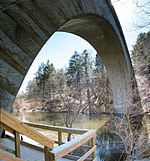Eliot station
Buildings and structures in Newton, MassachusettsFormer Boston and Albany Railroad stationsGreen Line (MBTA) stationsMassachusetts Bay Transportation Authority stubsMassachusetts railway station stubs ... and 3 more
Railway stations in Middlesex County, MassachusettsRailway stations in the United States opened in 1959Tram stubs

Eliot station is a light rail station on the MBTA Green Line D branch located just north of Route 9 (Boylston Street) between the Newton Highlands and Newton Upper Falls villages of Newton, Massachusetts. The station has a parking lot at the end of Lincoln Street, a pedestrian entrance from Meredith Avenue, and pedestrian entrances from both sides of Route 9. A footbridge, built in 1977, crosses Route 9 adjacent to the railroad bridge.
Excerpt from the Wikipedia article Eliot station (License: CC BY-SA 3.0, Authors, Images).Eliot station
Meredith Avenue, Newton Newton Upper Falls
Geographical coordinates (GPS) Address External links Nearby Places Show on map
Geographical coordinates (GPS)
| Latitude | Longitude |
|---|---|
| N 42.318888888889 ° | E -71.216388888889 ° |
Address
Eliot (Inbound)
Meredith Avenue
02464 Newton, Newton Upper Falls
Massachusetts, United States
Open on Google Maps










